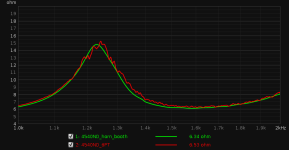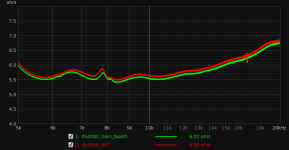Ok, perhaps I have a bit of conclusion on the impedance wiggle issue. It looks like I severely under-estimated the compression driver and horn combo's ability to pick-up ambient noise. Of course it's then more obvious that putting it on a horn amplifies said noise to the driver's exit - actually entrance in this case - and placing it face-down on the table makes for a clean trace.
I was able to repeat my test on BMS 4540ND mounted on the JBL 6" PT waveguide in a hearing aid practitioner's soundproof booth, with all the same gear and settings and the trace comes out much cleaner.
The laptop and/or audio interface self-noise is there on the trace, mostly noticeable as a fuzz on lower measured impedance levels above 4kHz or so. The noise creates a peak-to-peak variation of ~0.04 ohm. Interesting thing I noticed with the help of the soundproof booth; when turning on the audio stream by opening REW's "'Measure" screen, I can actually hear the high-pitch jittery noise from the laptop hardware!
I don't have the graphs with me now, but will post them later to better demonstrate the above findings.
I was able to repeat my test on BMS 4540ND mounted on the JBL 6" PT waveguide in a hearing aid practitioner's soundproof booth, with all the same gear and settings and the trace comes out much cleaner.
The laptop and/or audio interface self-noise is there on the trace, mostly noticeable as a fuzz on lower measured impedance levels above 4kHz or so. The noise creates a peak-to-peak variation of ~0.04 ohm. Interesting thing I noticed with the help of the soundproof booth; when turning on the audio stream by opening REW's "'Measure" screen, I can actually hear the high-pitch jittery noise from the laptop hardware!
I don't have the graphs with me now, but will post them later to better demonstrate the above findings.
I had wrongfully dismissed that issue despite several factors pointing towards it, hindsight 20/20 and all... I almost decided not to try the soundproof booth thinking the USB interface noise dominated at that point.
Thanks to all who chimed-in regarding the two issues!
Thanks to all who chimed-in regarding the two issues!
Hello,I have this speaker I designed and built almost 10 years ago, AE TD15M in 5cu.ft reflex with BMS 4550 on QSC waveguide, active with MiniDSP 2x4 and 4 channels of ICEpower 50ASX2. I've been doing some modifications and improvements, such as bracing and absorption and was taking measurements to re-evaluate the crossover.
When measuring the impedance for the tweeter, I get wiggles on the response curve. I don't recall these from back then, nor from other drivers, but it's been a long time and I used different gear and software back then. Here are a few traces I took as a bit of a sanity check. I'm using REW with a Behringer UCA222 interface and impedance jig with 96ohm resistor, full-calibration.
In case the naming conventions in my legend are a bit arcane:
Violet: 8R2 resistor
Yellow: naked BMS 4540ND, on the edge of a table
Blue: BMS 4540ND on JBL 6" PT waveguide, on the edge of a table
Green: BMS 4550 (unit A) on QSC waveguide, mounted on the enclosure
Red: BMS 4550 (unit B) on QSC waveguide, mounted on the enclosure
View attachment 1015769
I wasn't up to detaching a 4550 from the speaker when measuring the above, but a recent 'naked' measurement showed a fairly 'clean' trace, comparable to the naked 4540ND.
It seems that the waveguide-mounted drivers have that wiggle. I was first doubting the seal of the BMS 4550 on the QSC, as I had noticed a certain bow of the mounting flange, but sanded the brackets slightly to bring it back flat and the driver exit seems quite well-fitted to the throat, with slight compression of the gasket material. The BMS 4540ND also fits the 6" JBL waveguide like a shoe, it's like they were made for each other.
My concern was initially with similar ripple on the IR of the tweeter, but I can't do anything louder than impedance measurements at this time in the evening, so hence the impedance comparison above. Here are the IR traces still, tweeter's to begin.
View attachment 1015771
The woofer's IR does not have these OTOH.
View attachment 1015770
So what could be going on here?
I have been reading the book "High Quality Horn Loudspeaker Systems" by Kolbrek and Dunker, Too heavy to hold in my lap inn bed.
I Googled and found your post today.
I have seen what I call saw-tooth ripple only in Compression-Driver horn/wave impedance plots. if it were bench vibrations or room reflections it would also show up in a mid-range plot once in a while.
Sales brochure impedance plots all have some degree of processing or smoothing employed. I prefer the raw unprocessed plots. The Audio Precision APX500 software gives you the option of unprocessed, unsmoothed plots.
Horns are acoustic transformers, they are not smooth or continuous from throat to mouth. Some manufactures even stuff the volume of the horn with foam to attenuate reflections.
It is my impression that the saw-tooth ripples are acoustic reflections within the throat/mouth volume of the horn/waveguide.
I think next I will look at Two-Tone IMD measurements at frequencies rich with reflections within a likely CD / Horn.
See the attached JBL D2 Compression Driver and M2 Waveguide.
Thanks DT
This impulse issue is shown in every measurement of Acoustic elegance 10/12/15 i ever saw.I was first scratching my head with the 2ms blip, but I guess It's a driver thing? It is unchanged with measuring distance afterall. I seem to remember another TD15M user chasing a similar issue, I'd have to search.
The 15s also all have a FR dip and slight resonance in the 500 ish area. Claimed by the mfg to only be due to rubber surrounds but still persists in all they're drivers etc.
Also as Data-Bass reviews pointed out the TD15Ms surround is not really suited to the 6mm xmax figures, unless changed recently. Lambda was renamed AE, and after the excursion numbers doubled without any changes to the driver. (+4mm for the 15s/x/h) etc.
While good quality, they have some well known and documented quirks.
And the very best designed drivers around, does not exhibit that IR issue as pointed out by Gedlee in this thread.
John K gave the best explanation for it in @Lynn Olson 's ,Beyond the Ariel thread, many years ago.
Check Hificompass measurements of the Lambda TD15X, the mentioned thread above.
another site showing it in several of the AE drivers: https://sites.google.com/site/drivervault/driver-measurements/15
And so on.

